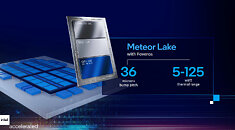- Joined
- Oct 9, 2007
- Messages
- 47,474 (7.50/day)
- Location
- Hyderabad, India
| System Name | RBMK-1000 |
|---|---|
| Processor | AMD Ryzen 7 5700G |
| Motherboard | ASUS ROG Strix B450-E Gaming |
| Cooling | DeepCool Gammax L240 V2 |
| Memory | 2x 8GB G.Skill Sniper X |
| Video Card(s) | Palit GeForce RTX 2080 SUPER GameRock |
| Storage | Western Digital Black NVMe 512GB |
| Display(s) | BenQ 1440p 60 Hz 27-inch |
| Case | Corsair Carbide 100R |
| Audio Device(s) | ASUS SupremeFX S1220A |
| Power Supply | Cooler Master MWE Gold 650W |
| Mouse | ASUS ROG Strix Impact |
| Keyboard | Gamdias Hermes E2 |
| Software | Windows 11 Pro |
Intel's next generation Core "Meteor Lake" processor was confirmed by ComputerBase.de to not release on the desktop platform. The processor will not make it to a socketed desktop package such as the upcoming LGA1851. It will see a mobile-only (notebook and tablets only) launch, with select processor models based on the mobile BGA package being made available to PC OEMs to build all-in-one desktops and mini PCs as non-socketed processors.
The desktop platform presence of "Meteor Lake" has been surrounded by some controversy, owing mainly to its maximum CPU core count of 6P+16E, which is bound to fall short of the current 8P+16E, and AMD's 16P. A slide released by Intel added to the confusion, which indicated that "Meteor Lake" has a thermal range of 5 W to 125 W, with the latter being typically associated with the processor base power values of desktop Core K-series processors.

Last week, in a statement to PC World, Intel Client Computing Group head Michelle Johnston Holthaus, implied that "Meteor Lake" will address all client form-factors, with desktop processor models arriving in 2024, a surprising disclosure, given that the company is preparing to launch its 14th Gen "Raptor Lake Refresh" processors within Q4-2023. "I want one processor family top to bottom for both segments, doesn't everybody?"
ComputerBase.de sought more explicit clarifications from Intel on whether by "desktop," Johnston Holthaus meant mainstream desktop (i.e. socketed processors). After some back and forth, Intel clarified that by "desktop," they meant prebuilt all-in-one desktops, which tend to be internally similar to notebooks and use low-TDP mobile processors; and mini PCs, such as from the NUC brand that ASUS recently acquired from Intel.
This wouldn't be the first time an Intel microarchitecture completely skipped mainstream desktop. The company's "Ice Lake" and "Tiger Lake" microarchitectures were limited to notebooks, convertibles, tablets; and a specific few SKUs made it to AIO desktops and mini PCs.
As for the mysterious 125 W reference in that slide, it could just refer to the maximum turbo power value of a certain higher-spec H- or HX-segment SKU. H- and HX-segment SKUs have been known to come with maximum turbo power values above the 100 W mark for some time now.
View at TechPowerUp Main Site | Source
The desktop platform presence of "Meteor Lake" has been surrounded by some controversy, owing mainly to its maximum CPU core count of 6P+16E, which is bound to fall short of the current 8P+16E, and AMD's 16P. A slide released by Intel added to the confusion, which indicated that "Meteor Lake" has a thermal range of 5 W to 125 W, with the latter being typically associated with the processor base power values of desktop Core K-series processors.

Last week, in a statement to PC World, Intel Client Computing Group head Michelle Johnston Holthaus, implied that "Meteor Lake" will address all client form-factors, with desktop processor models arriving in 2024, a surprising disclosure, given that the company is preparing to launch its 14th Gen "Raptor Lake Refresh" processors within Q4-2023. "I want one processor family top to bottom for both segments, doesn't everybody?"
ComputerBase.de sought more explicit clarifications from Intel on whether by "desktop," Johnston Holthaus meant mainstream desktop (i.e. socketed processors). After some back and forth, Intel clarified that by "desktop," they meant prebuilt all-in-one desktops, which tend to be internally similar to notebooks and use low-TDP mobile processors; and mini PCs, such as from the NUC brand that ASUS recently acquired from Intel.
This wouldn't be the first time an Intel microarchitecture completely skipped mainstream desktop. The company's "Ice Lake" and "Tiger Lake" microarchitectures were limited to notebooks, convertibles, tablets; and a specific few SKUs made it to AIO desktops and mini PCs.
As for the mysterious 125 W reference in that slide, it could just refer to the maximum turbo power value of a certain higher-spec H- or HX-segment SKU. H- and HX-segment SKUs have been known to come with maximum turbo power values above the 100 W mark for some time now.
View at TechPowerUp Main Site | Source



 As a home user, I'd much rather see a significant leap less often than a small step every year anyway.
As a home user, I'd much rather see a significant leap less often than a small step every year anyway.

